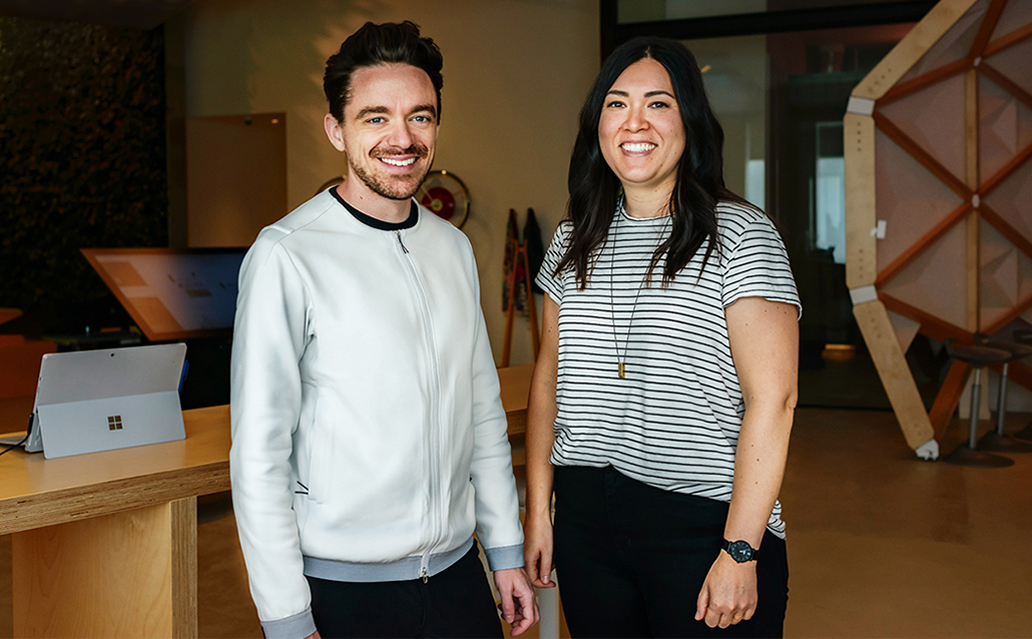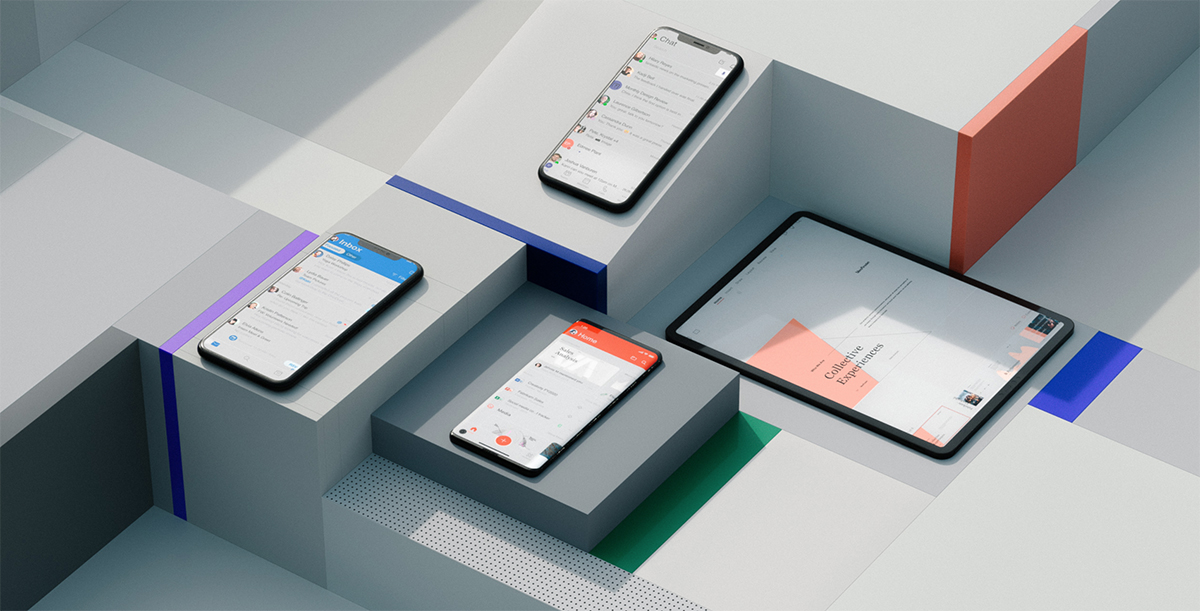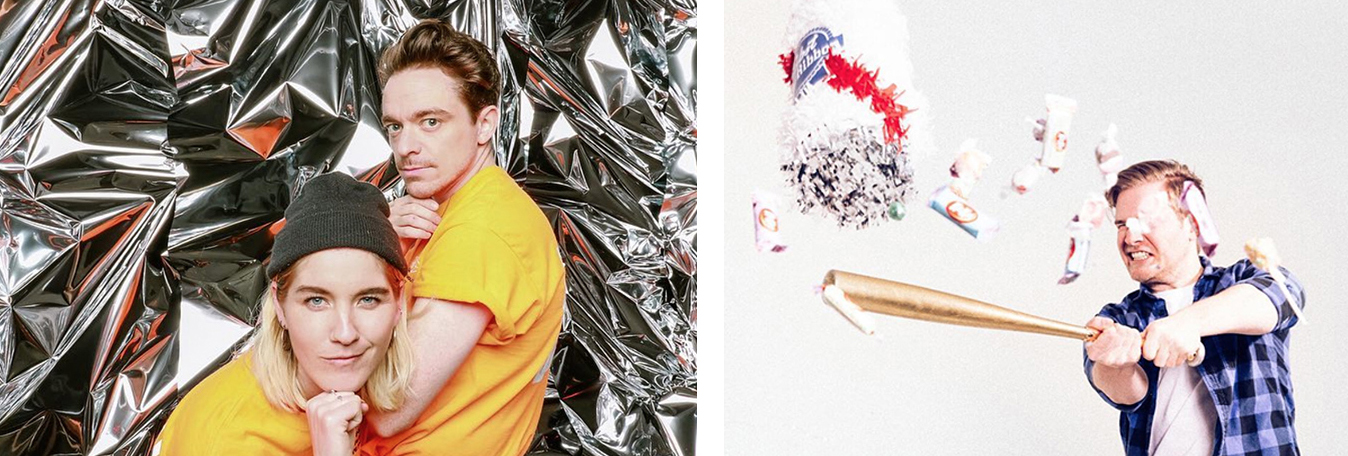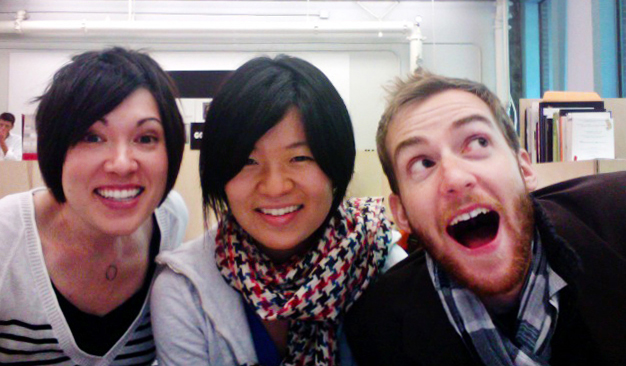Stephen Bader (UW IxD BDes 2014) and Alanna MacGowan (UW MFA 2010) work at Microsoft Envisioning. The Envisioning team explores how people will live, work, and play five to seven years in the future.
Because technology can change dramatically, describing a possible future isn’t enough—it’s best to let people experience it themselves. Visitors can do this in Microsoft Envisioning’s NEXT space, a physical showcase of interactive prototypes and multimedia presentations.
Stephen and Alanna are responsible for researching, designing, and building aspirational stories and prototypes that show real-life scenarios for inclusion in the NEXT space. The goal of their work is to provoke strategic discussion, instigate positive change for the future, and create a shared vision between Microsoft and its customers and partners.

The Next Generation Meeting Hexagon is designed for advanced video conferencing that allows multi-dimensional interactions between in-person and remote participants. For example, colored light cues indicate the status of the space: green for available, red for in use, and blue for open. Thomas Ham, former MS Senior Experience Designer on the Envisioning Team (UW VCD 2006) is second from the right.

Alanna with Director Anton Andrews
in the NEXT Space.
What is Microsoft Envisioning?
Stephen: Envisioning is the “blue-sky” research lab of Microsoft. Often Microsoft product teams are focused on shipping a product or service in the near term—they don’t have the bandwidth to make long-term and holistic product visions.
At Microsoft Envisioning, we can gather a broad view of the ever-shifting social and cultural landscape to anticipate new user needs for products and services across the company. We usually start by conducting ethnographic research, where we identify opportunities and user needs and create points of view around our findings. We develop narratives around these viewpoints and create physical and digital immersive prototypes to explore possible solutions to bring it all to life. We design each prototype for a specific user and setting. We then showcase them in the home of the future or office of the future environments at the NEXT Space. Other times we’ll communicate these ideas through videos that show a specific futuristic scenario or use case.
The work we produce is aimed to help inform each product team’s long-term roadmap. So, the Envisioning team essentially acts as a kind of “North Star”— we set a guiding vision that is a forward point of inspiration for all Microsoft products.
Alanna: It’s really important to get engineers and partners excited and inspired to build that new product. Our director, Anton Andrews, has really done a great job of strategically bringing Microsoft Envisioning closer to Microsoft products, so what we do is clearly relevant and impactful for the company.
For example, during the last year Stephen and I have been working on a visual language refresh for the NEXT Space that builds off of ongoing Fluent design language and M365 principles and strategies. This Fluent design system is a collection of standards for design and front end code. It’s a library of proven, reusable design components and assets with a guide on how to use them. The goal of it is to help teams achieve higher efficiency, consistency, and scalability when building digital products.
We’ve partnered closely with the product teams to better align our aspirational language to design initiatives that have momentum and energy behind them. This aspirational language is meant to provoke and inspire a new direction — we try to create a holistic vision for how all the elements we develop could work together and how that experience would feel. Because we don’t have a lot of the constraints the product teams have in terms of creating visual elements that can be engineered within the next 12-18 months, we can be more playful and expressive, going beyond existing UX (user experience) paradigms. We push towards conveying the maturity and sophistication Microsoft is known for, while still feeling friendly, soft, and familiar.
The UW design program does a great job of keeping people connected.
How did you get your job at Microsoft Envisioning?
Alanna: I think I saw a post from Prof. Karen Cheng (UW Visual Communication Design) advertising the open position because a previous UW Design alum, Tom Ham (VCD, 2006), was on the Envisioning team. At the time, the team was looking for a contractor for visual design. I was interested in the team because of the future-driven work that was happening there. I contracted for two years and then decided to make it permanent.
Stephen: I had an internship at Microsoft on the Windows Phone team when I was still at UW—the summer between my junior and senior year. I actually didn’t expect that I would ever work for a company like Microsoft after graduation; I thought it would just be a fun experiment and a chance to learn something new. But that internship was actually a really great experience. So when I got an offer to come back to Microsoft full-time after graduation, I did.
I think both of our experiences getting here show the value of the UW network. The UW design program does a great job of keeping people connected.
What does your typical day look like?
Alanna: With the nature of the work that we do, we don’t really have a typical day. Everyday is different. Some days are full of meetings, other days are focused on research, brainstorms, workshops — both internally and externally. We have long stretches of heads down production work, but those days are always mixed with other responsibilities as well. The work we do is so varied and our days reflect that. You have to be comfortable with ambiguity.
Stephen: We all have to wear different hats. It’s a small team that has to be agile. Things are always shifting and morphing.
How many people are on your team?
Alanna: Envisioning is a small, ten person team. Stephen and I cover UX and visual design, but we have industrial design, research, engineering, operations for the NEXT Space and our director.
Because we’re a small team our roles tend to be quite flexible. Stephen’s primary role is UX and strategy and mine is creative direction and visual design, but there’s so much overlap and other roles to fill along the way it’s hard to say we do one thing.
Stephen: We often have multiple projects going, so everybody has some piece of work in the same pie. You’re always jumping in and out.
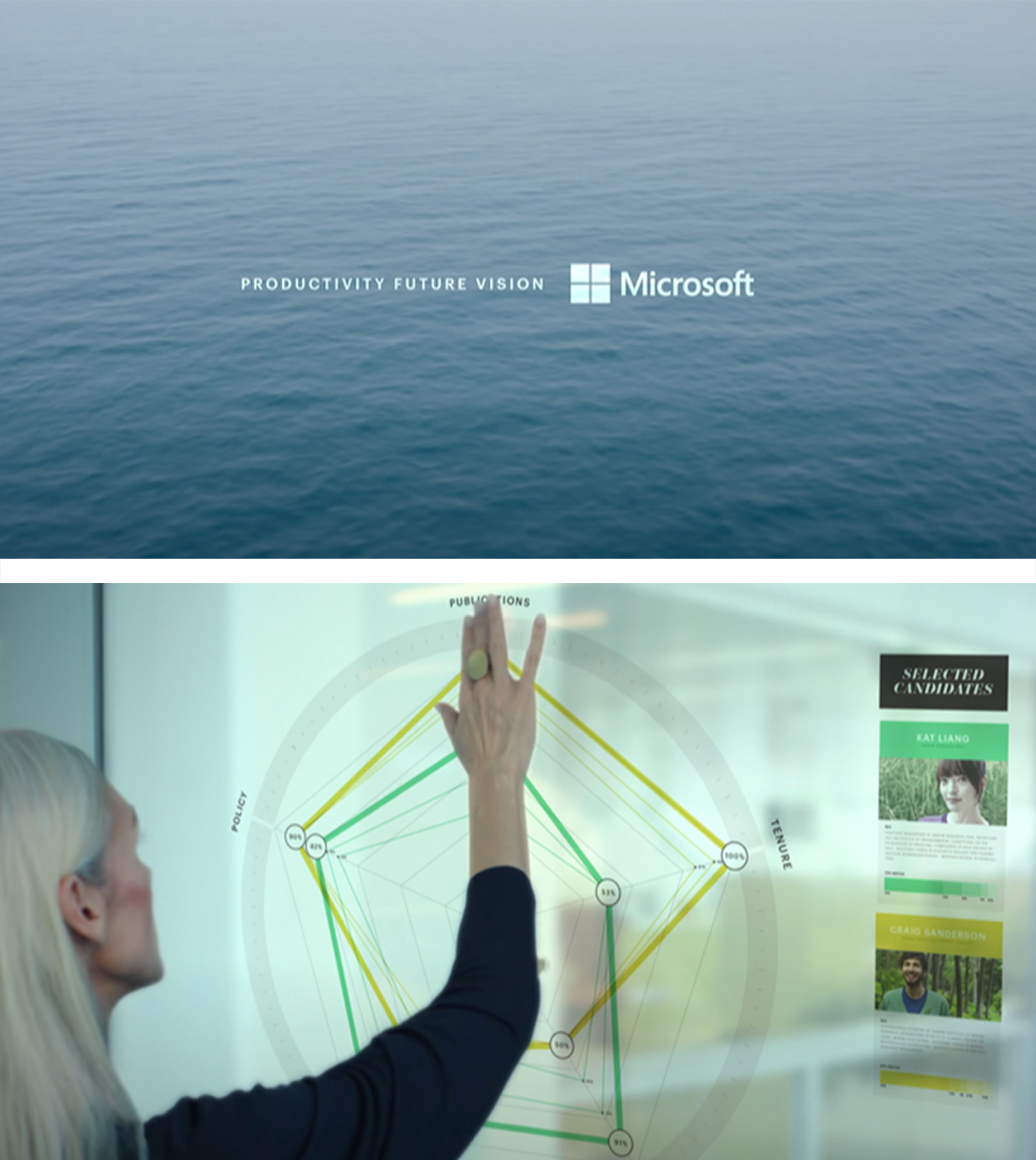
The 2015 Productivity Future Vision Video explored how emerging technologies will influence how we work five to seven years in the future.
Can you share one of your favorite projects that you’ve worked on?
Alanna: The Productivity Future Vision video was the first project I worked on when I joined the team seven years ago and it’s still one of my favorites. From research to narrative to storyboarding and production, it was one of the most collaborative projects I’ve ever worked on. It also had the most moving parts. Everyone on the team had a hand in every aspect of the process, so it was such an amazing learning opportunity.
Stephen: One of my favorites is the Desk Demo, an ongoing project exploring individual and collaborative digital canvases. Every app experience is actually a siloed experience. This forces us to switch modes each time we move between apps like PowerPoint, Excel, or Word, even when we are working on one project or task. It’s not an ideal experience for anyone because it breaks your workflow and doesn’t allow you to work as fluidly as you would naturally with following your train of thought. In the demo, we explore how we can break down application silos more seamlessly across experiences, bringing the user the right tools and content at the right time. Our aim is to help users focus on what’s important and stay connected with their colleagues.
This project not only accounts for designing the digital experience but also the hardware and the physical environment where the user may be. Figuring out how all of these elements harmonize together to build a holistic and robust solution is a fun and interesting challenge to explore.
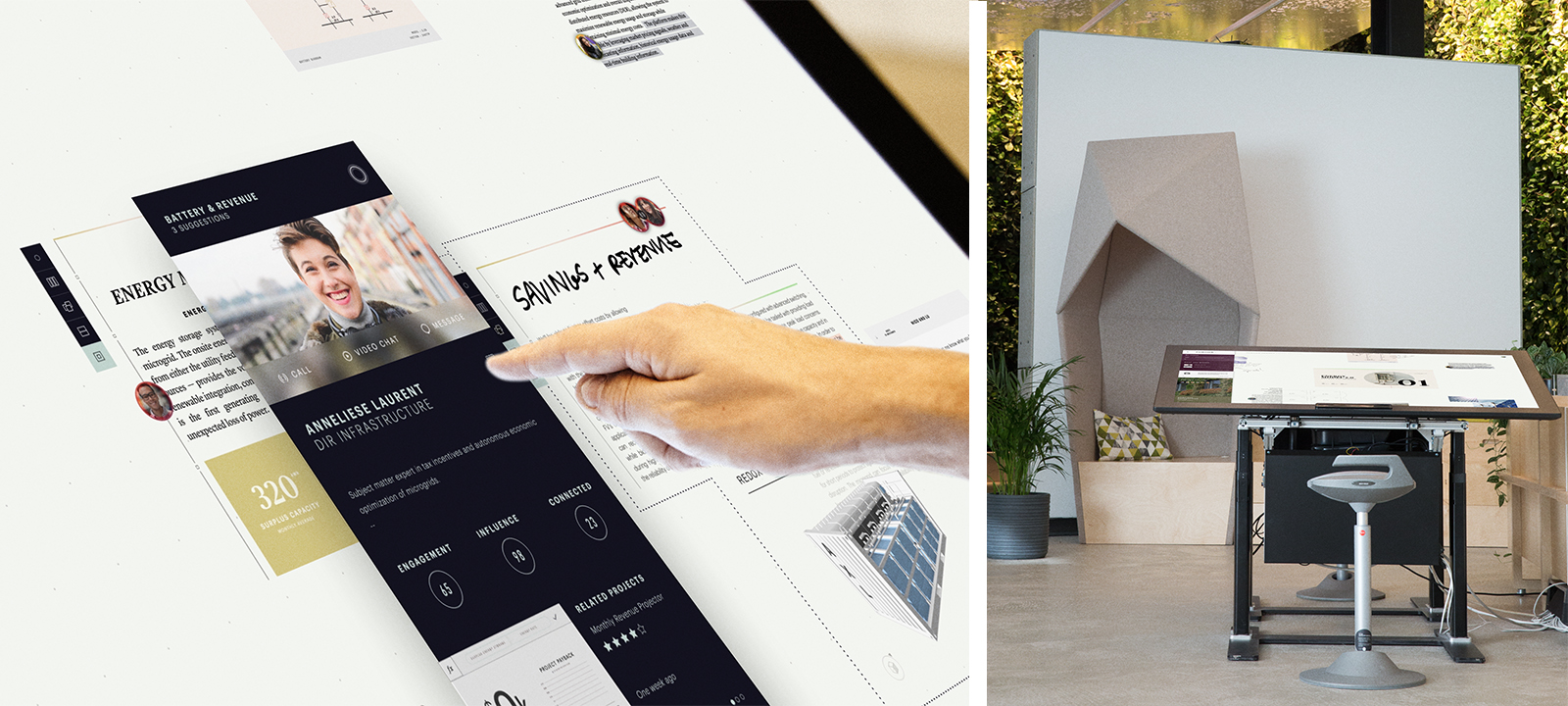
The Desk Demo shows a future concept of how a large-format, interactive, and fluid work station might look and feel more seamless, without the interruption of switching between applications.

Tomorrow's Living Room helps connect loved ones from afar in immersive and interactive ways.
What does the design process look like?
Alanna: It’s like any other human-centered design process. We start with understanding the problem, identifying our audience, identifying their needs, and building solutions around that.
Stephen: When we’re learning about the audience or the problem, we’re focused on getting to the core issue. We look for key insights, then prototype something that can be tested by users. When we get feedback on the prototype, we will adjust it and build forward until we have a product or experience that we can put into the NEXT Space.
Alanna: Everything we do is very strategic. What we do has to be relevant to the products and the strategy of Microsoft overall. If we have a cool idea, we have to build a business case around it. There needs to be a reason for a new product or service, and there needs to be a place for it. Initiatives need to make sense within the framework of all the work being done at Microsoft..
You have to be comfortable with ambiguity.
Are there design critiques?
Stephen: Constantly. Every time we work on a project and meet with partner teams, we are showing our work and getting feedback. The critiques often come from our partners within Microsoft, outside user testing, and from other members on the Envisioning team. Because our work is so ad-hoc and projects are often ambiguous, critiques happen constantly throughout the day.
Alanna: It’s not just about critiquing visuals, a lot of the time it’s about asking ourselves: are we solving the right problem? Are we taking the right point of view? Is the narrative engaging and clearly communicating what we’re trying to say?
We not only ask ourselves these questions, but we’re constantly getting feedback from our partner teams to make sure we’re heading in the right direction with the vision for the company.

The Hello Poster Show was founded by Ben Shown and Alanna MacGowan. Poster sales benefit local charities.
What do you do outside of work for creative stimulation?
Alanna: Actually, anything that is tactile and non-tech is great, because it helps to ground me and create balance. For example, I took up ceramics and I’m trying to learn how to watercolor. I also like practicing and improving my drawing skills…and gardening.
Stephen: I think I have a better perspective when I’m not always designing in the context of technology. Like Alanna, I have side projects that are all based on wanting to work with physical stuff.
I have a project called Disco Nap that I run with another UW Design alum, Taylor Nelson (VCD, 2014). We build site-specific installations and interactive elements for events. We use cheap materials to build really fun, large-scale installations. We get to be creative in ways that are different than in our day jobs.
Alanna: Stephen and I also run another “accidental business”—the Hello Poster Show. I started it with Ben Shown (MFA, 2010) in grad school as a fun way to make silk-screened posters. We held a series of online and pop-up fundraising exhibitions where we sold silkscreen posters designed by local artists and graphic designers. The exhibitions raised money for local charities, such as the ACLU of Washington, Girls Who Code, Gay City, and Kids in Need of Defense (KIND).
Once Stephen joined the project, we reworked and built the Hello Poster Show into a more robust and open platform. Now we have small-scale riso prints, tote bags, and other items. We recently partnered with Microsoft on a few shows to cover the cost of manufacturing the items for sale (in the past, the designers themselves had to cover the costs).
Since we collaborate with a lot of other disciplines, being able to understand and speak the languages of those disciplines is really important.
Do you have any advice about the do's and don'ts in the interview or hiring process?
Alanna: When you’re interviewing, you should know that the interview is just as much for you as it is for the person that’s hiring. Make sure that you do your due diligence. You should know who they are and what the company or team does. Then you can ask the right questions to see if the place is a fit for you.
Stephen: Look out for the red flags. For example, if the interviewer doesn’t seem like they’re interested, if they’re not giving you respect, or even intimidating you, that’s probably not a place where you want to work. The work will never outweigh the people that you’re working with. Those are important signals to pass on the opportunity and move on.
During an interview or portfolio review, students always want to show projects that they think are most relevant to the job. But I’m personally more inspired by projects that you’re passionate about. I want to see your personality and the things that get you excited. Then I can look for your design knowledge—what your process was like, how you went about executing a design, etc.
Alanna: I think that point of view speaks to the type of work that we do at Envisioning—we have to do so many different things. So, it’s important for us to get a full and robust picture of who you are and what you’re capable of. But like any job, you’re probably going to have to do more than what the job posting described.

